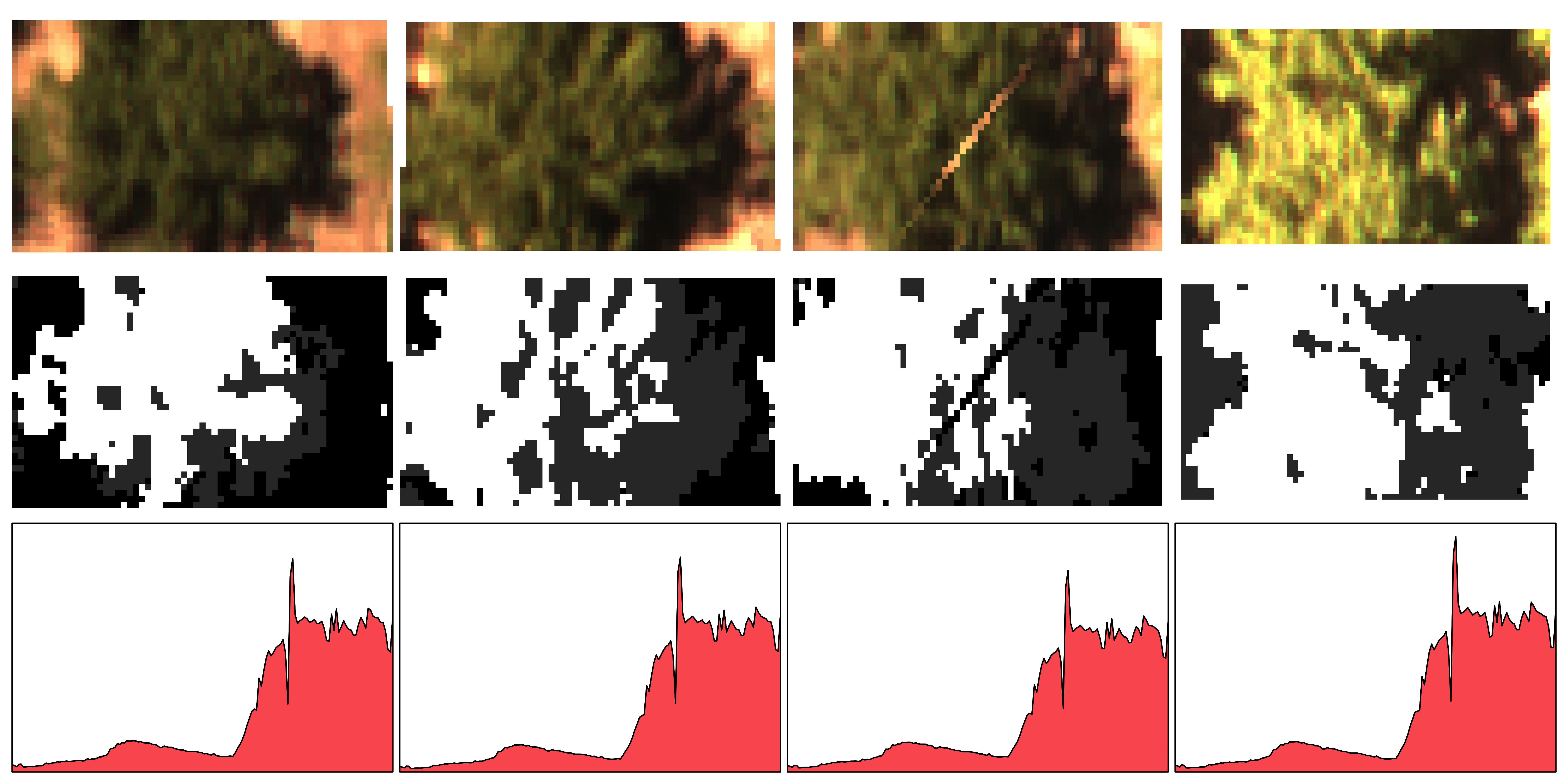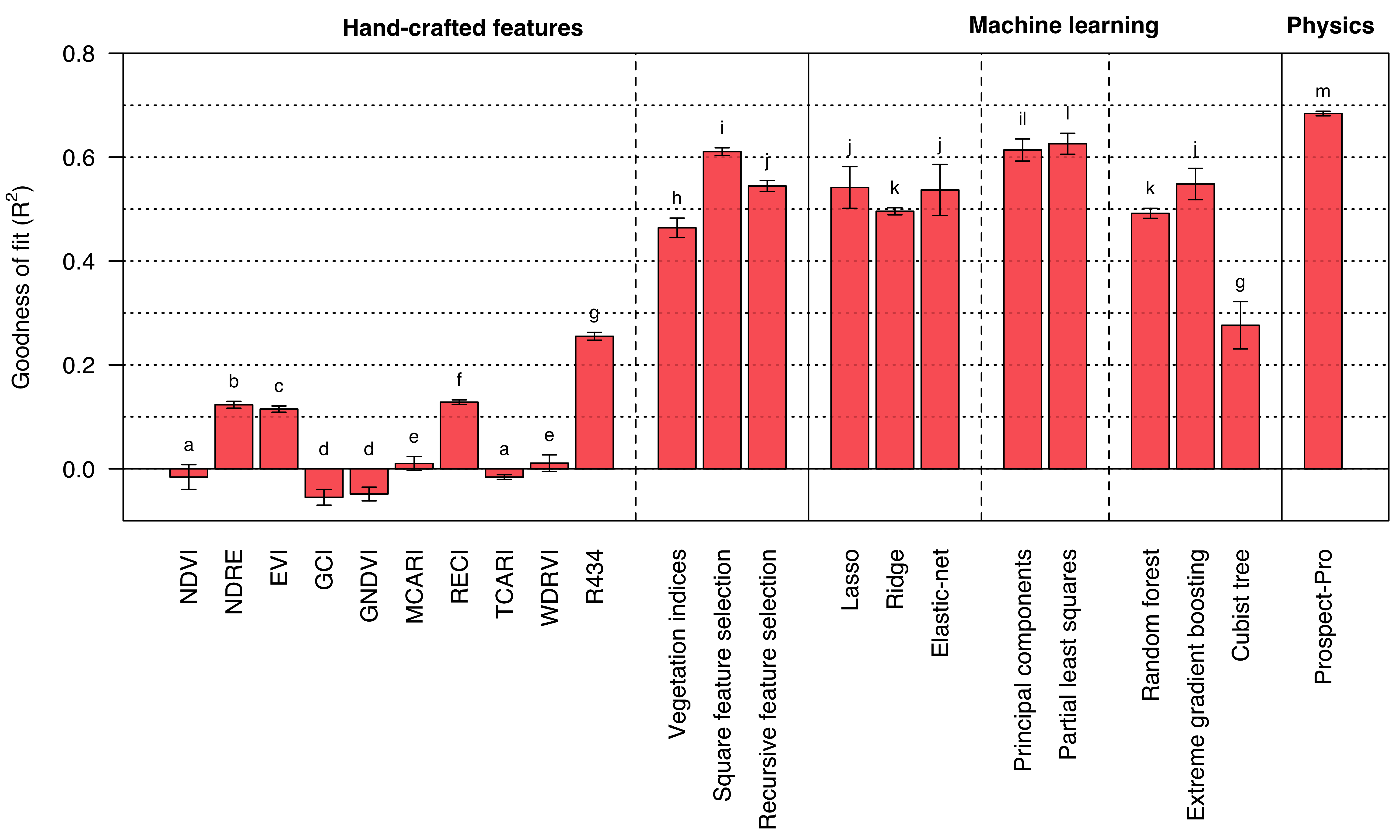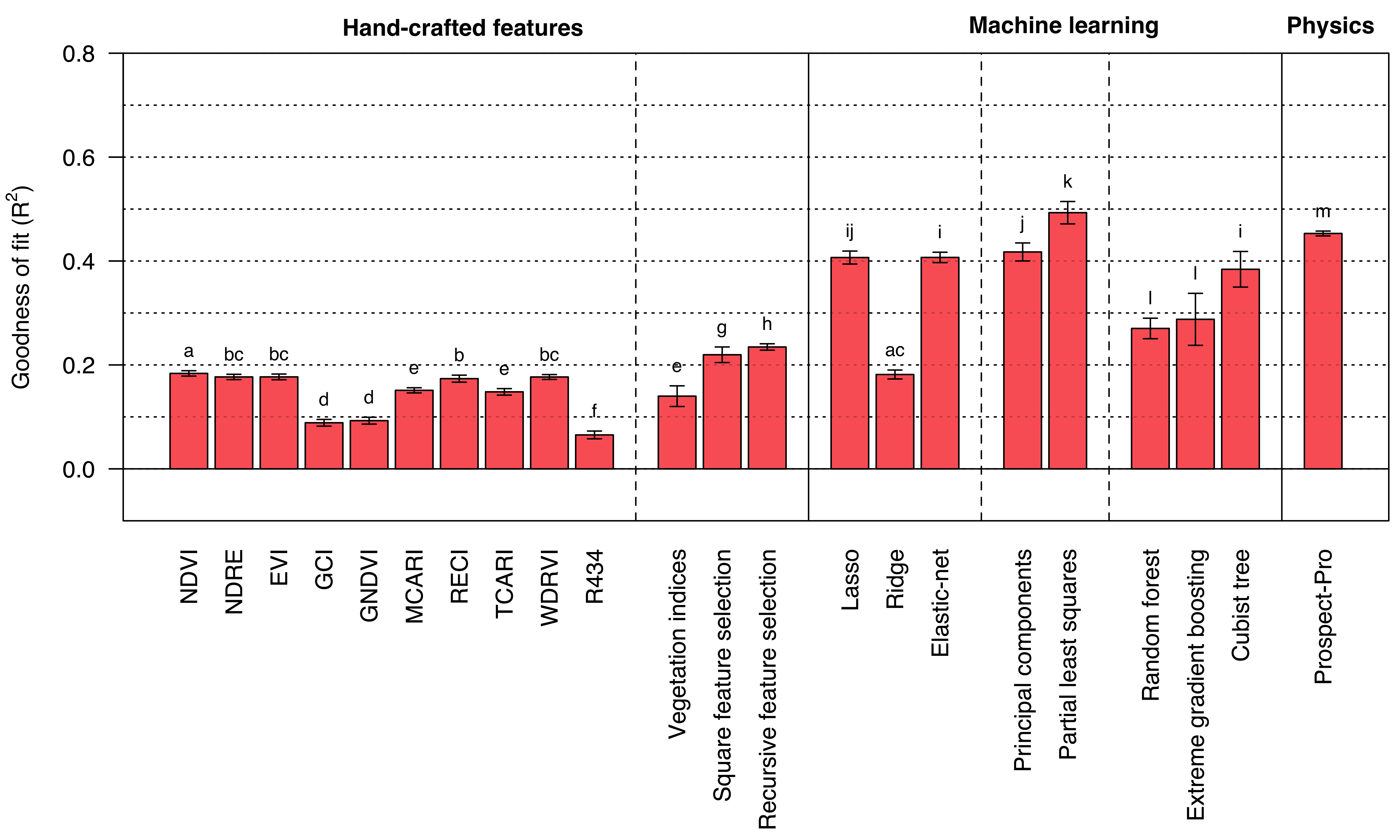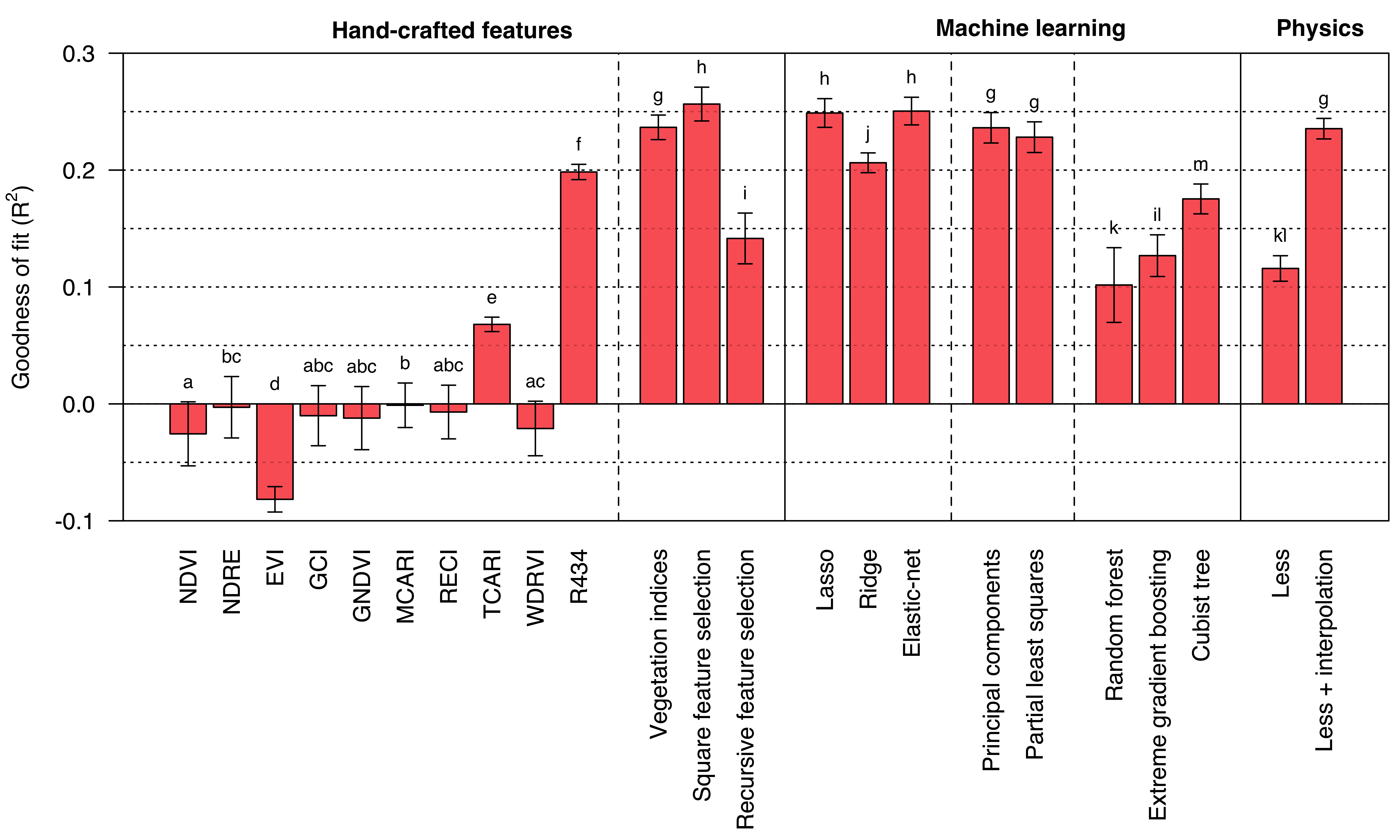Remote Sensing of Foliar Nitrogen in Californian Almonds
Master thesis presentation
April 11, 2024
Background
Almonds and nitrogen
- California is the largest producer of almonds with a production share of roughly 80% (CDFA 2020).
Almonds are a profitable but also intensive crop, where the recommended nitrogen application ranges between 130 and 285 kg N ha-1 a-1 (Brown et al. 2020).
Nitrogen leaching negatively impacts ecological systems and can affect the water supply quality (Yang et al. 2008).
Remote sensing of crop nitrogen for an adequate fertilization is one of the core promises of precision agriculture (Walter et al. 2017).
Goal of this thesis
- Model the foliar nitrogen concentration based on hyperspectral images or spectroradiometric measurements.
\[ f: \boldsymbol \rho \in \mathbb R^{d} \longrightarrow \text{N}_{\%} \in \mathbb R \tag{1}\]
- Produce a model that is generalizable to datasets from other orchards and other years (and possibly even other crops).
Modelling approaches
I was trying out different modelling approaches to predict foliar nitrogen concentration from spectral data.
- Hand-crafted features (e.g. vegetation indices).
- Machine learning (purely data-driven).
- Modelling physical processes using radiative transfer models.
For this presentation, the focus will heavily lie on radiative transfer models.
Explanation of the data
Location of the almond orchard
Hyperspectral data

Figure 1: Westwind almond orchard in Woodland, CA (left). Explanation of hyperspectral images (right).
Pre-processing of the data

Figure 2: Segmentation process to extract the mean spectral reflectance from the hyperspectral images.
Irradiance, radiance, and reflectance



Overview of the data sets
Leaf-level and canopy-level data was used for this thesis, both referring to the same target trees.
| Level | Observations | Bands | Range | Sensor |
|---|---|---|---|---|
| Leaf | 124 | 1024 | 338 - 2512 nm | HR-1024i |
| Canopy | 107 | 151 | 385 - 900 nm | Pika L |
Leaf-level radiative transfer modelling
The Prospect model
- Prospect (leaf optical property spectra) is a radiative transfer model first introduced by Jacquemoud (1992).
- It simulates the reflectance and transmittance of a leaf given the content of plant pigments (and some other plant parameters). \[ f: [\mathbf c, N, \alpha] \in \mathbb R^{9} \rightarrow [\boldsymbol \rho, \boldsymbol \tau] \in \mathbb R^{2\times 2101} \tag{2}\]
- The function \(f\) is constructed from established laws of physics.
The parameters of Prospect
| Abbreviation | Parameter | Unit | |
|---|---|---|---|
\(\mathbf c\) |
CHLCARANTBROWNEWTPROTCBC |
Chlorophyll content Carotenoid content Anthocyanin content Tannin content Equivalent water thickness Protein content Carbon-based constituent content |
\(\mu \text{g cm}^{-2}\) \(\mu \text{g cm}^{-2}\) \(\mu \text{g cm}^{-2}\) \(-\) \(\text{g cm}^{-2}\) \(\text{g cm}^{-2}\) \(\text{g cm}^{-2}\) |
| \(N\) | N |
Leaf mesophyll structure parameter | |
| \(\alpha\) | alpha |
Solid angle for incident light at surface of leaf | \(^{\circ}\) |
Physics behind Prospect
We start out with equations describing s- and p-polarized transmission and reflection by Fresnel (1821), where \(n\) is the refractive index. \[ \scriptstyle t_s(\theta, n) = \frac{4\sqrt{1-\sin^2 \theta} \sqrt{n^2-\sin^2 \theta}}{\left(\sqrt{1-\sin^2 \theta} + \sqrt{n^2-\sin^2 \theta}\right)^2} \qquad t_p(\theta, n) = \frac{4n^2\sqrt{1-\sin^2 \theta} \sqrt{n^2-\sin^2 \theta}}{\left(n^2\sqrt{1-\sin^2 \theta} + \sqrt{n^2-\sin^2 \theta}\right)^2} \tag{3}\] We are interested in the transmissivity for diffuse light coming from all angles \(\theta\) between \(0\) and \(\frac{\pi}{2}\). \[ \scriptstyle \overline{T} = \frac{\int_0^{2\pi} d\varphi \int_0^{\alpha} t(\theta,n) \cos \theta \sin\theta d \theta}{\int_0^{2\pi} d\varphi \int_0^{\alpha} \cos \theta \sin\theta d \theta} \tag{4}\] The Fresnel equations were integrated by Allen (1973) for a general case of the maximum incidence angle \(\alpha\), both for s-polarized transmissivity:
\[ \scriptstyle \begin{aligned} T_s(\alpha, n) = \frac{1}{96}\frac{(n^2-1)^4}{\left[\sqrt{\left(\sin^2 \alpha -\frac{1}{2} (n^2 + 1)\right)^2 -\frac{1}{4} (n^2 - 1)^2} - \sin^2 \alpha +\frac{1}{2} (n^2 + 1)\right]^3} - \\\ \frac{1}{4}\frac{n^4 - 2n^2 +1}{\sqrt{\left(\sin^2 \alpha -\frac{1}{2} (n^2 + 1)\right)^2 -\frac{1}{4} (n^2 - 1)^2} - \sin^2 \alpha + \frac{1}{2} (n^2 + 1)} - \\\ \frac{1}{2} \left( \sqrt{\left(\sin^2 \alpha -\frac{1}{2} (n^2 + 1)\right)^2 -\frac{1}{4} (n^2 - 1)^2} - \sin^2 \alpha + \frac{1}{2} (n^2 + 1) \right) + \\\ \frac{1}{12} \frac{(n^2 - 1)^4}{(n + 1)^6} + \frac{1}{2} \frac{(n^2-1)^2}{(n+1)^2} + \frac{1}{4} (n^2+2n+1) \end{aligned} \tag{5}\]
As well as for p-polarized transmissivity:
\[ \scriptstyle \begin{aligned} T_p(\alpha, n) = \frac{-2 n^2}{(n^2 + 1)^2} \left[ \sqrt{\left(\sin^2 \alpha - \frac{1}{2} (n^2 + 1)\right)^2 - \frac{1}{4} (n^2 - 1)^2} - \sin^2 \alpha + \frac{1}{2} (n^2 + 1) - \frac{1}{2} (n + 1)^2 \right] - \\\ \frac{2 n^2 (n^2 + 1)}{(n^2-1)^2} \cdot \ln \left[ \sqrt{\left(\sin^2 \alpha - \frac{1}{2} (n^2 + 1)\right)^2 - \frac{1}{4} (n^2 - 1)^2} - \frac{\sin^2 \alpha - \frac{1}{2}(n^2 + 1)}{(n+1)^2} \right] + \\\ \frac{1}{2} n^2 \left\{ \left[ \sqrt{\left(\sin^2 \alpha - \frac{1}{2} (n^2 + 1)\right)^2 - \frac{1}{4} (n^2 - 1)^2} - \sin^2\alpha - \frac{1}{2} (n^2 + 1)\right]^{-1} - \frac{2}{(n + 1)^2} \right\} + \\ \frac{16n^4 (n^4 + 1)}{(n^2+1)^3(n^2-1)^2} \cdot \ln \left[\frac{ 2 (n^2 + 1) \left(\sqrt{\left(\sin^2 \alpha - \frac{1}{2} (n^2 + 1)\right)^2} - \sin^2 \alpha + \frac{1}{2} (n^2 + 1)\right) - (n^2 - 1)^2}{(n^2 + 1)(n + 1)^2 - (n^2-1)^2} \right] + \\\ \frac{16 n^6}{(n^2 + 1)^3} \left[ {2 (n^2 + 1) \left(\sqrt{\left(\sin^2 \alpha - \frac{1}{2} (n^2 + 1)\right)^2} - \sin^2 \alpha + \frac{1}{2} (n^2 + 1)\right) - (n^2 - 1)^2} \right]^{-1} - \\\ \frac{16n^6}{(n^2 + 1)^3\left( (n^2 + 1) (n + 1)^2 - (n^2 - 1)^2 \right)} \end{aligned} \tag{6}\]
Combine the two above to get the average transmissivity \(\overline{T}\) as a function of \(\alpha\) and \(n\).
\[ \scriptstyle \overline{T}(\alpha, n) = \frac{T_s(\alpha, n) + T_p(\alpha, n)}{2 \cdot \sin^2 \alpha} \tag{7}\]
The overall absorption coefficients \(k\) of a wavelength \(\lambda\) can be calculated as a weighted sum of specific absorption coefficients \(s\), where the weights are the content of the plant pigments. These specific absorption coefficients were empirically estimated by Féret et al. (2021).
\[ \scriptstyle k_\lambda = \frac{1}{N} \sum_i c_i s_{i,\lambda} \tag{8}\]
Given this coefficient vector, we can calculate the transmission for isotropic light \(\varphi\) for every wavelength \(\lambda\) with \(k = k_\lambda\) using the upper incomplete gamma function according to the Beer-Lambert law (Lambert 1760; Beer 1852).
\[ \scriptstyle \varphi = (1 - k) \cdot e^{-k} + k^2 \cdot \Gamma(k) = (1 - k) \cdot e^{-k} + k^2 \cdot \int_k^\infty \frac{e^{-t}}{t} dt \tag{9}\]
Given all of the equations above, Jacquemoud (1992) wrote the first implementation of the Prospect model. \[ \scriptstyle \begin{aligned} A = \frac{ \varphi \: \overline T(90, n)} { n^2\left[1 - \varphi^2 \: \left(1 - n^{-2} \: \overline T(90, n) \right)^2\right] } \qquad B = \overline T(90, n) \: A \\[15pt] C = 1 - \overline T(90, n) + \varphi \: B \: \left(1 - \frac{\overline T(90, n)}{n^2}\right) \\[15pt] D = \sqrt{(1 + C + B) \: (1 + C - B) \: (1 - C + B) \: (1 - C - B)} \qquad E = \frac{1 + C^2 - B^2 + D}{2\,C} \\[15pt] F = \frac{1 - C^2 + B^2 + D}{2\,B} \qquad G = F^{N-1} \qquad H = \frac{E \, (G^2 - 1)}{E^2 \, G^2 - 1} \end{aligned} \tag{10}\] Everything can be put together to get the spectral reflectance \(\rho\) and transmittance \(\tau\) of a leaf. \[ \scriptstyle \rho = 1 - \overline T(\alpha, n) \left[ 1 + \varphi \, A \left(1 - \frac{\overline T(90, n)}{n^2} \right) + \frac{A \, H \, B}{1 - H \, C} \right] \tag{11}\] \[ \scriptstyle \tau = \frac{\overline T(\alpha, n) \, A \, G \, (E^2 - 1)}{(E^2 \, G^2 - 1) \, (1 - H \, C)} \tag{12}\]
Interactive demonstration
The inversion problem
- Radiative transfer models are constructed in the forward mode: we calculate the reflectance given leaf parameters.
- In reality, we are dealing with the inverse problem: we already know the reflectance, but want to find the parameters. This is called the backward mode. \[ f: x \to y \qquad \qquad f^{-1}: y \to x \tag{13}\]
- The inversion can be achieved via (1) optimization, (2) a look-up table or (3) machine learning.
Canopy-level radiative transfer modelling
The Less model
- The Less model (large-scale emulation system for forest simulation) is a ray tracing model developed by Qi et al. (2019).
- It simulates a three-dimensional scene given the spectral reflectance of every material used.
- Less is computationally much more intensive than Prospect and also includes many more parameters.
- The inversion of Less was achieved using a look-up table.
Modelling the orchard scene

Figure 3: The preliminarily used three-dimensional model of an almond tree (A) and how it is arranged to represent a tree in the orchard (B).
Observation vs. simulation

Figure 4: An RGB representation of the hyperspectral data which was observed (C) compared to the one that was simulated (D).
Look-up-table regression
- Generated a look-up table containing 16’500 simulations.
- Given one observation, we find its closest match in the look-up table by minimizing a cost function \(J\). \[ J = \frac{1}{d} \sum_{\lambda=1}^d w_i\left( \rho_{\lambda,\text{obs.}} - \rho_{\lambda,\text{sim.}} \right)^2 \tag{14}\]
- Make smooth predictions by applying hyper-dimensional interpolation (multicubic polynomial surrogate model).
Results of the model performances
Leaf level results (area-based N)

Figure 5: Results based on a 50 times repeated 20-fold cross validation.
Leaf level results (mass-based N)

Figure 6: Results based on a 50 times repeated 20-fold cross validation.
Canopy level results

Figure 7: Results based on a 50 times repeated 20-fold cross validation.
Discussion
Machine learning or physics?
- Machine learning models work well, but they tend not to be robust if applied to settings outside their training data.
- Physics-based models may provide this robustness while maintaining a similar level of accuracy (Berger et al. 2018).
- These models also push the understanding of the subject more than machine learning models do.
- Machine learning serves well as an indicator of what level of accuracy should be expected.
Range of the nitrogen measurements
- Data set covers a commercial almond orchard fertilized according to the recommendations. The measured N% ranges between 1.96 and 3.17%.
- Much of the published research focuses on fertilization trials, where nitrogen deficiency is artificially induced.
- Healthy distrust of nitrogen measurements – they are no absolute ground truth.
Improving canopy-level predictions
- Include information in the short-wave infrared spectrum from more advanced sensors.
- Spatial information can be combined with spectral information to predict foliar nitrogen concentrations.
Conclusion
- Nitrogen remote sensing research should focus on crops that are fertilized according to standard practice.
- Radiative transfer models are promising as a robust method of estimating plant traits which can be connected to N%.
- Prospect predictions shows discrepancies with observed data: chlorophyll could be split into chlorophyll a and b.
- Spectral resolution is not that important – but the range covered is (especially short-wave infrared).
References
Remote sensing of foliar nitrogen in Californian almonds